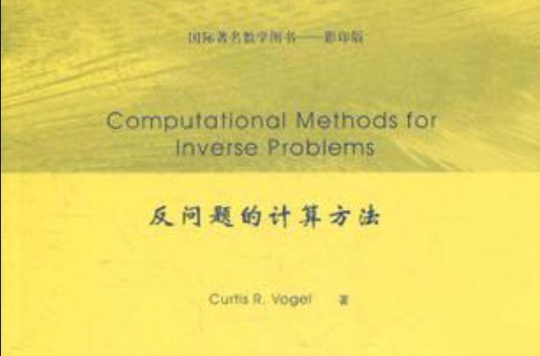《反問題的計算方法》是清華大學出版社2011年出版的圖書,由沃格爾編著。
基本介紹
- 中文名:反問題的計算方法
- 出版社:清華大學出版社
- 時間:2011年
- 開本:16
圖書信息,作者簡介,內容簡介,目錄,
圖書信息
出版社: 清華大學出版社; 第1版 (2011年2月1日)
外文書名: Computational Methods for Inverse Problems
叢書名: 國際著名數學圖書
平裝: 183頁
正文語種: 英語
開本: 16
ISBN: 7302245029, 9787302245025
條形碼: 9787302245025
尺寸: 24.4 x 17 x 1.2 cm
重量: 281 g
作者簡介
作者:(美國)沃格爾(Curtis R.Vogel)
Curtis R. Vogel is a Professor in the Department of Mathematical Sciences at Montana State University. His research interests include numerical analysis, mathematical modeling, optimization, inverse and ill-posed problems, and scientific computing. He has written many refereed articles and reports on these topics.
內容簡介
《反問題的計算方法(影印版)》內容簡介:inverse problems arise in a number of important practical applications, ranging from biomedical imaging to seismic prospecting. this book provides the reader with a basic understanding of both the underlying mathematics and the computational methods used to solve inverse problems. it also addresses specialized topics like image reconstruction, parameter identification, total variation methods, nonnegativity constraints, and regularization parameter selection methods.
because inverse problems typically involve the estimation of certain quantities based on indirect measurements, the estimation process is often ill-posed. regularization methods, which have been developed to deal with this illposedness, are carefully explained in the early chapters of computational methods for inverse problems. the book also integrates mathematical and statistical theory with applications and practical computational methods, including topics like maximum likelihood estimation and bayesian estimation.
several web-based resources are available to make this monograph interactive, including a collection of matlab m-files used to generate many of the examples and figures. these resources enable readers to conduct their own computational experiments in order to gain insight. they also provide templates for the implementation of regularization methods and numerical solution techniques for other inverse problems. moreover, they include some realistic test problems to be used to develop and test various numerical methods.
computational methods for inverse problems is intended for graduate students and researchers in applied mathematics, engineering, and the physical sciences who may encounter inverse problems in their work.
目錄
foreword
preface
1 introduction
1.1 an illustrative example
1.2 regularization by filtering
1.2.1 a deterministic error analysis
1.2.2 rates of convergence
1.2.3 a posteriori regularization parameter selection
1.3 variational regularization methods
1.4 iterative regularization methods
exercises
2 analytical tools
2.1 ill-posedness and regularization
2.1.1 compact operators, singular systems, and the svd
2.1.2 least squares solutions and the pseudo-inverse
2.2 regularization theory
2.3 optimization theory
2.4 generalized tikhonov regularization
2.4.1 penalty functionals
2.4.2 data discrepancy functionals
2.4.3 some analysis
exercises
3 numerical optimization tools
3.1 the steepest descent method
3.2 the conjugate gradient method
3.2.1 preconditioning
3.2.2 nonlinear cg method
3.3 newton's method
3.3.1 trust region globalization of newton's method
3.3.2 the bfgs method
3.4 inexact line search
exercises
4 statistical estimation theory
4.1 preliminary definitions and notation
4.2 maximum likelihood'estimation
4.3 bayesian estimation
4.4 linear least squares estimation
4.4.1 best linear unbiased estimation
4.4.2 minimum variance linear estimation
4.5 the em algorithm
4.5.1 an illustrative example
exercises
5 image deblurring
5.1 a mathematical model for image blurring
5.1.1 a two-dimensional test problem
5.2 computational methods for toeplitz systems
5.2.1 discrete fourier transform and convolution
5.2.2 the fft a, lgorithm
5.2.3 toeplitz and circulant matrices
5.2.4 best circulant approximation
5.2.5 block toeplitz and block circulant matrices
5.3 fourier-based deblurring methods
5.3.1 direct fourier inversion
5.3.2 cg for block toeplitz systems
5.3.3 block circulant preconditioners
5.3.4 a comparison of block circulant preconditioners
5.4 multilevel techniques
exercises
6 parameter identification
6.1 an abstract framework
6.1.1 gradient computations
6.1.2 adjoint, or costate, methods
6.1.3 hessian computations
6.1.4 gauss-newton hessian approximation
6.2 a one-dimensional example
6.3 a convergence result
exercises
7 regularization parameter selection methods
7.1 the unbiased predictive risk estimator method
7.1.1 implementation of the upre method
7.1.2 randomized trace estimation
7.1.3 a numerical illustration of trace estimation
7.1.4 nonlinear variants of upre
7.2 generalized cross validation
7.2.1 a numerical comparison of upre and gcv
7.3 the discrepancy principle
7.3. i implementation of the discrepancy principle
7.4 the l-curve method
7.4.1 a numerical illustration of the l-curve method
7.5 other regularization parameter selection methods
7.6 analysis of regularization parameter selection methods
7.6.1 model assumptions and preliminary results
7.6.2 estimation and predictive errors for tsvd
7.6.3 estimation and predictive errors for tikhonov regularization
7.6.4 analysis of the discrepancy principle
7.6.5 analysis of gcv
7.6.6 analysis of the l-curve method
7.7 a comparison of methods
exercises
8 total variation regularization
8.1 motivation
8.2 numerical methods for total variation
8.2.1 a one-dimensional discretization
8.2.2 a two-dimensional discretization
8.2.3 steepest descent and newton's method for total variation
8.2.4 lagged diffusivity fixed point iteration
8.2.5 a primal-dual newton method
8.2.6 other methods
8.3 numerical comparisons
8.3.1 results for a one-dimensional test problem
8.3.2 two-dimensional test results
8.4 mathematical analysis of total variation
8.4.1 approximations to the tv functional
exercises
9 nonnegativity constraints
9.1 an illustrative example
9.2 theory of constrained optimization
9.2.1 nonnegativity constraints
9.3 numerical methods for nonnegatively constrained minimization
9.3.1 the gradient projection method
9.3.2 a projected newton method
9.3.3 a gradient projection-reduced newton method
9.3.4 a gradient projection-cg method
9.3.5 other methods
9.4 numerical test results
9.4.1 results for one-dimensional test problems
9.4.2 results for a two-dimensional test problem
9.5 iterative nonnegative regularization methods
9.5.1 richardson-lucy iteration
9.5.2 a modified steepest descent algorithm
exercises
bibliography

